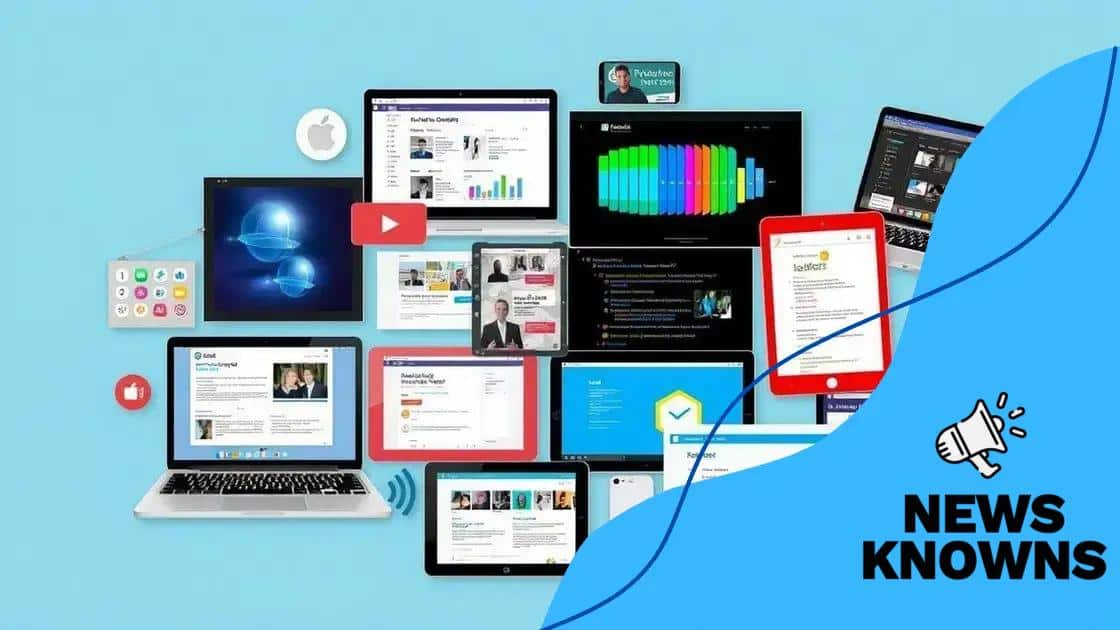The rise of asynchronous learning in universities

Anúncios
The rise of asynchronous learning in universities allows students to study at their own pace, utilizing technology to create personalized educational experiences while addressing the challenges of accessibility and engagement.
The rise of asynchronous learning in universities is changing the way students engage with their studies. Have you noticed how flexibility in learning can impact your educational journey? Let’s dive into what this means for you.
Anúncios
Understanding asynchronous learning
Understanding asynchronous learning is crucial in today’s educational landscape. Many students benefit from the flexibility it offers, allowing them to learn at their own pace. This method has changed how classes are structured, especially in universities.
The concept revolves around students accessing course materials anytime, anywhere. This is particularly appealing for those balancing work, family, or other commitments. With the rise of online platforms, education has adapted to meet diverse needs.
Key Characteristics of Asynchronous Learning
Asynchronous learning typically involves several important features:
Anúncios
- Flexible learning schedules that allow students to access materials at their convenience.
- Variety of resources, including videos, readings, and discussion boards.
- Opportunities for self-paced learning and assessments.
This flexibility is beneficial, enabling students to absorb material thoroughly, while also fitting education into their busy lives. However, it requires self-discipline and time management.
Benefits for Students
Many students find that asynchronous learning enhances their educational experience. Here are some advantages:
- Increased engagement, as students can revisit lectures or materials as needed.
- Personalized learning paths catering to individual needs and preferences.
- Improved access to resources that may not be available in traditional settings.
As more universities adopt this method, the emphasis on student-centered learning continues to grow. Overall, asynchronous learning fosters a dynamic educational environment that benefits a wide range of learners.
Benefits of asynchronous learning for students

Asynchronous learning offers several benefits for students, making it an appealing choice for modern education. This approach allows learners to engage with materials when it suits them best, leading to a more personalized learning experience.
One of the major advantages is the flexibility it provides. Students can study and complete assignments around their schedules, which is especially beneficial for those who are balancing jobs or family responsibilities. This flexibility empowers students to take control of their education.
Key Benefits of Asynchronous Learning
Here are some of the most notable benefits:
- Self-paced learning: Students can move through the material at their own speed, allowing for better comprehension and retention.
- Accessibility: Resources are available online, making education accessible from anywhere with internet connectivity.
- Variety of learning materials: Students often have access to diverse resources, including videos, readings, and interactive tools.
The flexibility of asynchronous learning not only supports academic success but also personal growth. As students navigate their studies, they develop important skills such as time management and self-discipline.
Personalized Learning Experience
In a traditional classroom, learning styles can vary significantly among students. Asynchronous learning allows each individual to explore resources that match their preferred learning methods. Some may thrive with visual aids, while others may prefer text-based content.
This level of customization often leads to increased engagement. Students are more likely to dive into materials that resonate with them, enhancing their overall understanding of the subject matter. By catering to different learning preferences, asynchronous learning creates a more inclusive education environment.
Challenges faced by universities
While asynchronous learning offers many benefits, it also presents several challenges faced by universities. These challenges can impact the effectiveness of implementing this learning style and the overall student experience.
One significant challenge is ensuring that all students have equal access to the necessary technology. Not every student may have a reliable internet connection or access to a computer. This digital divide can create disparities in learning opportunities.
Key Challenges in Adopting Asynchronous Learning
Universities need to navigate several common obstacles when integrating asynchronous learning:
- Student engagement: Keeping students motivated in a self-paced environment can be difficult. Many may feel isolated and miss the interaction of traditional classrooms.
- Quality of materials: Developing high-quality online content requires significant time and resources. Universities must ensure that materials are engaging and educational.
- Assessment issues: Evaluating student performance in asynchronous formats can be complex, as traditional testing methods may not apply effectively.
Additionally, faculty training is also essential. Instructors must adapt to new teaching methods and learn how to effectively facilitate asynchronous classes. This transition can be demanding for educators who are used to traditional teaching styles.
Potential Solutions for Universities
Despite these challenges, many universities are finding ways to improve the asynchronous learning experience. They are investing in better technology and training, as well as exploring innovative teaching strategies.
Moreover, creating community-building activities online can help combat feelings of isolation. Engaging discussion forums and group projects encourage students to connect and collaborate. By addressing these challenges, universities can enhance the learning experience for all students.
Technological tools enabling asynchronous education

Technological tools are vital for enabling asynchronous education, transforming how students learn. These tools provide the frameworks necessary for flexibility and engagement in the learning process.
Many universities utilize learning management systems (LMS) that host course materials, track progress, and facilitate communication. These platforms allow students to access lectures, assignments, and grades anytime, fostering an environment where learners can thrive at their own pace.
Essential Tools for Asynchronous Learning
Here are a few key technological tools that are shaping asynchronous education:
- Learning Management Systems (LMS): Platforms like Canvas and Blackboard help organize courses and streamline communication between instructors and students, making resources easily accessible.
- Video Conferencing Tools: Applications such as Zoom or Microsoft Teams allow for recorded lectures, enabling students to revisit lessons whenever they wish.
- Discussion Boards: Online forums encourage interaction among students and instructors, facilitating ongoing discussions that deepen understanding of the material.
- Interactive Content: Tools that allow for quizzes, polls, and multimedia can make learning more engaging and cater to different learning styles.
Using these tools helps create a robust online learning experience. Students can engage with diverse formats that appeal to their preferences, whether that’s visual, auditory, or textual. Additionally, technology helps track progress, enabling personalized learning paths.
Emerging Technologies
As technology continues to advance, new tools are being developed to enhance asynchronous education further. Artificial intelligence is becoming a significant part of this transformation, helping to analyze student performance and suggest personalized resources.
Furthermore, virtual and augmented reality tools are starting to enter education, offering immersive learning experiences previously unimaginable. These technologies can enrich the learning process, allowing students to explore complex subjects more intuitively.
Future trends in asynchronous learning
The future trends in asynchronous learning promise to reshape education significantly. As technology evolves, so do the methods and practices used in online and distance learning. This shift is opening new possibilities for students and educators alike.
One trend is the increased use of artificial intelligence (AI) in assessing student performance. AI can provide personalized feedback and learning paths, helping students navigate content tailored to their needs. This level of customization can lead to improved retention and understanding.
Key Future Trends
As we look ahead, several key trends are emerging in asynchronous learning:
- Microlearning: This approach focuses on delivering content in small, bite-sized chunks. Students can engage with brief lessons that fit into their schedules, making learning more manageable.
- Gamification: Incorporating game design elements into learning can enhance engagement. Features like badges, points, and leaderboards make the learning experience more interactive and enjoyable.
- Collaborative Learning Platforms: Future platforms will focus on enabling collaboration among students, even in an asynchronous format. These tools will facilitate peer-to-peer learning and group projects, enriching the educational experience.
Another important trend is the integration of virtual reality (VR) and augmented reality (AR) into asynchronous courses. These technologies allow for immersive learning experiences that can bring complex concepts to life, helping students visualize content in new ways.
Adaptive Learning Technologies
Adaptive learning is gaining traction, meaning that educational programs will adjust in real-time to meet the needs of individual learners. This approach focuses on the student’s pace and learning style, leading to a more effective educational experience. As institutions continue to invest in these technologies, asynchronous learning will become increasingly dynamic and responsive.
With these advancements, the potential for asynchronous learning appears vast. As the demand for flexible educational options grows, the tools and methods used will continue to evolve, providing students with enriching and tailored learning experiences.
FAQ – Frequently Asked Questions about Asynchronous Learning
What is asynchronous learning?
Asynchronous learning allows students to access course materials and complete assignments at their own pace, providing flexibility in their education.
What are the benefits of asynchronous learning?
Benefits include flexibility in scheduling, personalized learning experiences, and the ability for students to revisit materials as needed.
What technologies support asynchronous learning?
Technologies such as learning management systems, video conferencing tools, and interactive resources play a significant role in enabling asynchronous education.
How can universities improve student engagement in asynchronous courses?
Universities can enhance engagement by incorporating discussion boards, interactive content, and community-building activities to foster collaboration.





